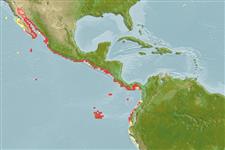>
Acanthuriformes (Surgeonfishes) >
Chaetodontidae (Butterflyfishes)
Etymology: Johnrandallia: After John Randall, marine biologist, Bishop Museum of Hawaii; he worked in systematic ichthyology with fishes of Indopacific region.
More on author: Gill.
Environment: milieu / climate zone / depth range / distribution range
Ökologie
seewasser riff-verbunden; tiefenbereich 6 - 40 m (Ref. 9286), usually 6 - 12 m (Ref. 9286). Tropical; 40°N - 10°S, 120°W - 70°W
Eastern Pacific: Gulf of California to Panama, including the Cocos, Malpelo and Galapagos Islands.
Size / Gewicht / Alter
Maturity: Lm ? range ? - ? cm
Max length : 20.0 cm TL Männchen/unbestimmt; (Ref. 9286); common length : 14.0 cm TL Männchen/unbestimmt; (Ref. 55763)
Rückenflossenstacheln (insgesamt) : 11 - 12; Rückenflossenweichstrahlen (insgesamt) : 24 - 25; Afterflossenstacheln: 3; Afterflossenweichstrahlen: 18 - 20. Body deep, compressed, and disk-shaped; dorsal profile of head steep and concave; snout pronounced; teeth very small and se in a comb-like band; base of pelvic spine with an axillary process; lateral line complete, extending over caudal peduncle; body yellowish; snout with a dark stain; eye bordered with black; posterior edge of operculum, base of pectoral fins, nape, and dorsal border (at base of dorsal fin) black (Ref. 55763).
Often in large schools (Ref. 5227) over coral and rocky reefs (Ref. 9286). Feed on algae, gastropods, and small crustaceans (Ref. 9286). Pick parasites from larger fishes like Paranthias colonus and Mulloides dentatus (Ref. 28023). Oviparous (Ref. 205). Form pairs during breeding (Ref. 205).
Life cycle and mating behavior
Maturities | Fortpflanzung | Spawnings | Egg(s) | Fecundities | Larven
Form pairs during breeding (Ref. 205).
Schneider, M., 1995. Chaetodontidae. Peces mariposa. p. 1000-1003. In W. Fischer, F. Krupp, W. Schneider, C. Sommer, K.E. Carpenter and V. Niem (eds.) Guia FAO para Identification de Especies para lo Fines de la Pesca. Pacifico Centro-Oriental. 3 Vols. FAO, Rome. (Ref. 9286)
IUCN Rote Liste Status (Ref. 130435)
Bedrohung für Menschen
Harmless
Nutzung durch Menschen
Fischereien: kommerziell; Aquarium: Kommerziell
Tools
Zusatzinformationen
Download XML
Internet Quellen
Estimates based on models
Preferred temperature (Ref.
123201): 17.9 - 29, mean 26.6 °C (based on 144 cells).
Phylogenetic diversity index (Ref.
82804): PD
50 = 1.0000 [Uniqueness, from 0.5 = low to 2.0 = high].
Bayesian length-weight: a=0.02818 (0.01685 - 0.04715), b=3.08 (2.94 - 3.22), in cm total length, based on LWR estimates for this species & (Sub)family-body (Ref.
93245).
Trophic level (Ref.
69278): 3.0 ±0.44 se; based on food items.
Widerstandsfähigkeit (Ref.
120179): hoch, Verdopplung der Population dauert weniger als 15 Monate. (Preliminary K or Fecundity.).
Fishing Vulnerability (Ref.
59153): Low vulnerability (10 of 100).
Nutrients (Ref.
124155): Calcium = 89.4 [47.0, 136.0] mg/100g; Iron = 0.773 [0.468, 1.239] mg/100g; Protein = 18.6 [17.4, 19.6] %; Omega3 = 0.114 [0.071, 0.177] g/100g; Selenium = 34.1 [19.7, 61.6] μg/100g; VitaminA = 46.2 [13.5, 153.7] μg/100g; Zinc = 1.4 [1.0, 2.0] mg/100g (wet weight);
